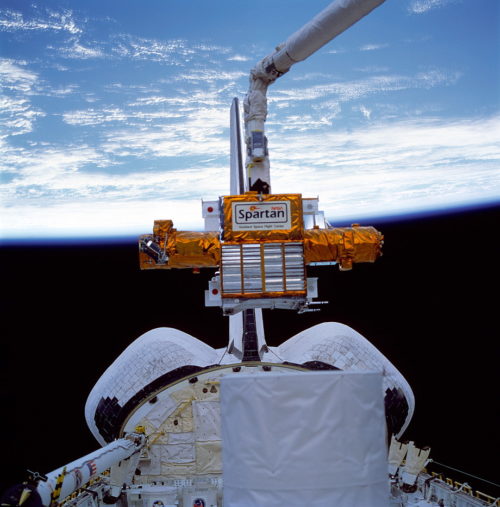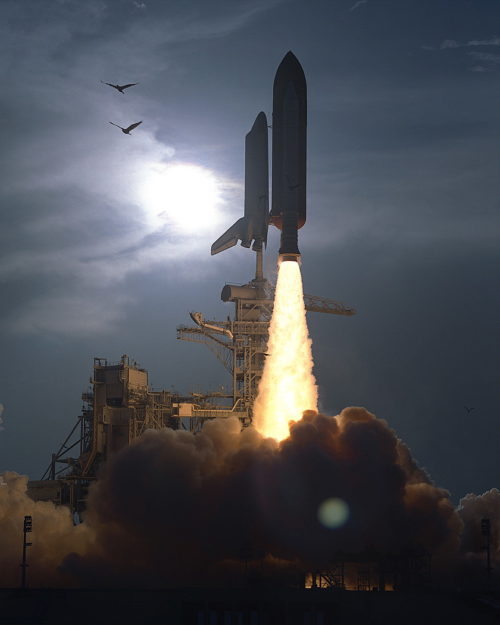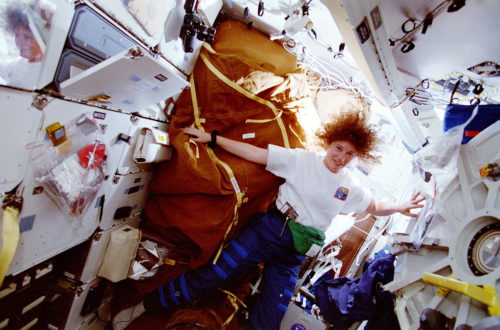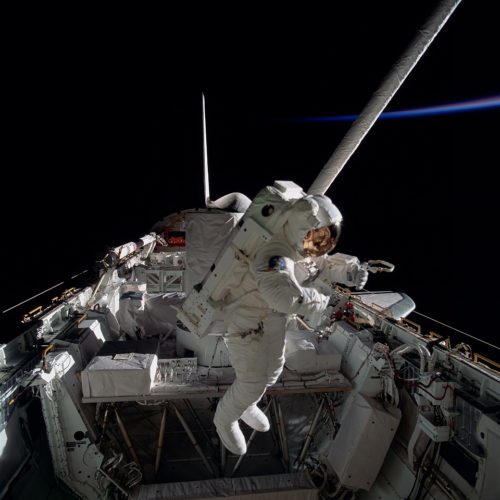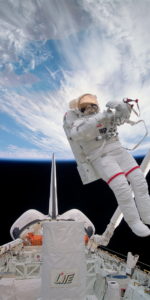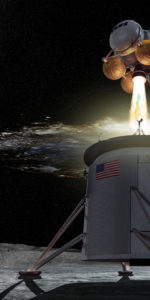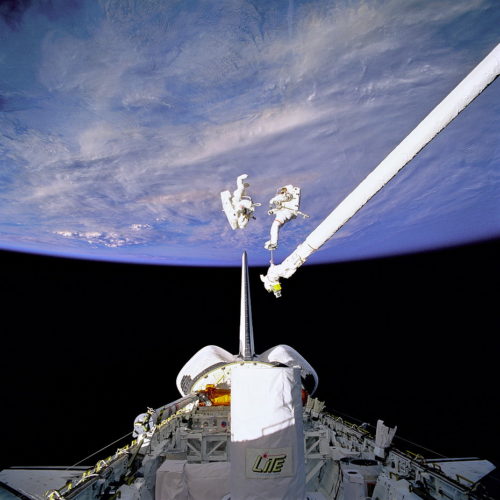
Spacewalkers Mark Lee (right) and Carl Meade work above Discovery’s payload bay during STS-64, 25 years ago, this month. Below them is the large telescope of their primary payload, the Lidar In-Space Technology Experiment (LITE) and, just behind it, the gold-colored mass of the SPARTAN solar physics satellite. Photo Credit: NASA
A quarter-century ago, this month, the crew of Discovery trialed virtually all of the Space Shuttle’s myriad capabilities: science and technology, satellite deployment, rendezvous and retrieval and—arguably most dramatic of all—spacewalking. As detailed in last weekend’s AmericaSpace history feature, STS-64 in September 1994 was notable in that it featured the first evaluation of the Simplified Aid for EVA Rescue (SAFER), a self-rescue tool which would permit spacewalkers to recover from becoming detached from their tether during an Extravehicular Activity (EVA). True to its name, SAFER would indeed offer a “safer” means of going about spacewalking and after astronauts Mark Lee and Carl Meade first tested it on STS-64 it has since entered operational service and its descendants are today used during EVAs aboard the International Space Station (ISS).
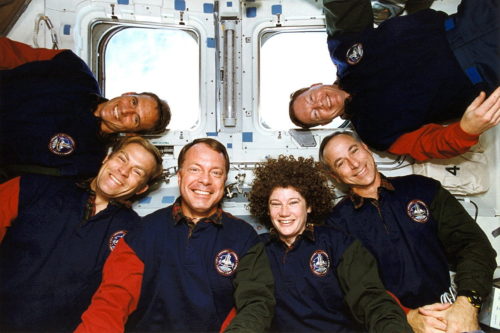
The STS-64 crew pose on Discovery’s flight deck. From left are Jerry Linenger, Mark Lee, Blaine Hammond, Susan Helms, Carl Meade and Dick Richards. Photo Credit: NASA
Yet the high-visibility nature of the spacewalk was only one facet of STS-64. When the bulk of the crew was named almost a year before launch, the core objectives of the flight were the deployment and recovery of the Shuttle Pointed Autonomous Research Tool for Astronomy (SPARTAN)—which would bring a suite of solar physics instrumentation to bear on our nearest star, the Sun—and operations with the Lidar In-Space Technology Experiment (LITE). The latter was tasked with directing narrow pulses of laser light in the atmosphere and utilizing a telescope to measure the reflectance qualities of clouds, suspended aerosol particles and the surface itself.
Developed by NASA’s Office of Advanced Concepts and Technology and Mission to Planet Earth, the usefulness of lidar as a remote-sensing tool derived from the fact that it could obtain very high vertical and horizontal resolutions and LITE marked the first occasion on which lidar had ever been employed in space for atmospheric observations. More than 43 hours of data were gathered and Discovery’s relatively low altitude of 160 miles (260 km) and high inclination of 57 degrees to the equator enabled LITE to cover a broad swathe of the Home Planet.
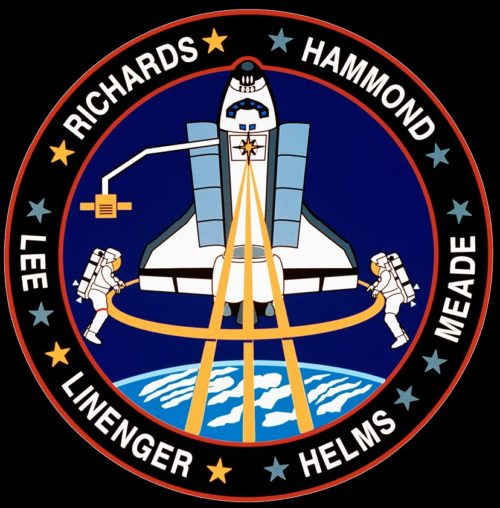
The STS-64 crew patch, containing the astronauts’ surnames and symbolic representations of the first SAFER spacewalking tests, the deployment of SPARTAN at upper left and the atmospheric research performed by LITE at center. Image Credit: NASA
Simultaneously, on the ground and in the air, investigators at more than 50 sites in 20 discrete countries made their own complementary observations. Five international aircraft flew directly “beneath” portions of Discovery’s flight path, covering parts of Europe, the southwestern United States, the Caribbean, South America and the South Atlantic. Mounted on a Spacelab pallet, LITE gathered its data during a series of ten sessions, each lasting 4.5 hours, as well as performing a handful of 15-minute “snapshots” of selected target sites. (These snapshot sites yielded “ground-truth” comparison points and included a lidar situated at NASA’s Langley Research Center in Hampton, Va.) The returning signals were converted to digital data and stored on tapes aboard Discovery for transmission to the ground.
“Lasers produce a tight, coherent beam that spreads very little as it travels from its source, compared to ordinary light,” noted NASA’s pre-mission press kit. “From its orbital altitude, LITE’s laser beam would spread to only about 980 feet (300 meters) wide at the surface. This allows the LITE instrument to measure a very small, narrowly-defined column of the atmosphere with each pulse.” With pulses transmitted ten times per second, and each lasting less than 30 billionths of a second, at precisely-known wavelengths corresponding to ultraviolet, infrared, and visible green light, it was possible to achieve a resolution of about 50 feet (15 meters). By the end of the first day of the mission, the LITE ground team was reporting “terrific-looking returns” from the instrument.
Operating throughout the mission—with operations temporarily suspended whilst Lee and Meade performed their spacewalk—LITE investigated the organization of cloud structures in the Western Pacific Ocean, together with cloud decks off the coasts of California and Peru, smoke plumes from biomass fires in South America and Africa and the transport of dust from the Sahara Desert. Additionally, low-atmosphere aerosols were examined over the Amazon rainforest and gravity waves (a mechanism that transfers momentum from the troposphere to the stratosphere) over the Andes and the reflection characteristics of desert surfaces in the United States, Africa, and China. LITE also dramatically outlined the structure of Super-Typhoon Melissa, providing unprecedented views of the storm’s eye. It was expected that the technology demonstration could lead to future satellites to perform year-round lidar observations of clouds, urban smog, or dust storms.
The LITE instrument took the form of a telescope and optics package with photomultiplier tubes to provide its visible green and ultraviolet sensitivity and a silicon avalanche photodiode for its infrared capability. Interestingly, the telescope was actually an engineering model from NASA’s 1960s-era Orbiting Astronomical Observatory (OAO) program, and its use for LITE reportedly saved the space agency $8 million. In spite of periodic laser shutdowns, caused by coolant-loop problems, NASA noted in its post-mission report that the system “performed more effectively than originally expected, demonstrating the ability of a lidar…to penetrate multiple clouds and aerosol layers down to the Earth’s surface.”
Liftoff of STS-64 occurred at 6:22 p.m. EDT on 9 September 1994, very close to the end of that day’s “window”, which opened at 4:30 p.m. and was due to close at 7:00 p.m. Launching late in the day came a pleasant surprise for many of the crew—Commander Dick Richards, Pilot Blaine Hammond and Mission Specialists Jerry Linenger, Susan Helms, Carl Meade and Mark Lee—who had participated in around-the-clock flights earlier in their careers, as it required little in the way of “sleep-shifting”. The late afternoon launch was required in order to permit “night” operations of LITE early in the mission, but weather violations close to Pad 39B required the six astronauts to wait uncomfortably on their backs for almost two hours later than planned. Until relatively late in the countdown, Launch Commit Criteria remained “Red” (“No-Go”) for flight through clouds greater than 45,000 feet (13,700 meters) and flight through thunderstorm clouds.
Upon arrival in orbit, however, the entire crew moved crisply about their tasks. By the time of Lee and Meade’s EVA on the 16th, LITE operations were well underway and the second primary objective of the mission—the deployment and retrieval of SPARTAN— had also been successfully concluded. On 13 September, Helms lifted the boxy satellite out of Discovery’s payload bay with the Canadian-built Remote Manipulator System (RMS) mechanical arm and released it into space. It spent the next two days performing observations of the solar corona with a white light coronagraph and ultraviolet coronal spectrometer. “After we left it, we did not really see it again, until our rendezvous sequence,” Helms related in the post-mission press conference. “It was out of our field of view.”
During the deployment, however, data from Discovery’s Ku-band rendezvous radar exhibited “questionable readings”, which Mission Control attributed to a late acquisition of SPARTAN. An hour after the satellite’s release, the radar passed several self-tests without obvious problems, but according to NASA’s post-mission report, “multiple searches were performed in both the General Purpose Computer and Automatic modes…all without success.” Finally, an hour after deployment, the Ku-band acquired the SPARTAN and remained locked onto its target until the Communications Mode was selected. However, as a contingency measure, and in case the radar was unavailable for retrieval, plans were developed for a “workaround” rendezvous profile on 15 September, possibly incorporating ground-based navigation data and the shuttle’s own star trackers.
“These procedures are not as precise and would require slightly more propellant than normal,” noted a Mission Control Center Status Report on the evening of the 14th, but acquiesced that “the propellant margins are adequate to support a “no-radar” rendezvous and the crew and flight control teams are trained for such a scenario.” As the situation evolved over the following hours, the radar posed no further difficulties, and from a distance of 24 miles (40 km) to just 82 feet (25 meters) it guided Richards perfectly into position for him to complete proximity operations and for Helms to grapple the satellite.
Elsewhere in the payload bay, a 33-foot (10-meter) instrumented extension boom for the RMS, known as the Shuttle Plume Impingement Flight Experiment (SPIFEX), was tested to gather data about the effect of dozens of thruster firings upon large structures, whilst other experiments focused on robotic materials processing, ozone-monitoring, the growth of seeds, the behavior of insects, the formation of superconductors, crystal growth and solar observations.
These payloads represented a wide range of investigators and a wide range of age groups, from young schoolchildren to higher academic institutions, and came from as far afield as Canada, China, Japan and the Netherlands, as well as the United States.
The mission had already been extended from nine to ten days, but the scheduled touchdown at the Kennedy Space Center (KSC) in Florida on 19 September dawned gloomy, with thunderstorms and low, thick cloud cover. Two opportunities existed to land on the East Coast on the 20th, together with two more at Edwards Air Force Base, Calif., and although Florida was the preferred option the weather finally turned against STS-64. Rain showers along the Space Coast made even the 20th a “No-Go” in terms of Mother Nature and Richards and his crew were diverted to California.
Under picture-perfect skies, Discovery swooped onto Runway 04 at Edwards at 2:12 p.m. PDT (5:12 p.m. EDT), concluding a voyage of a little less than 11 full days. The mission had put virtually all of the shuttle’s capabilities—satellite deployment and retrieval, scientific research, multiple payloads, proximity operations and EVA—to the test and served to prepare the fleet for space station construction.
.
.
FOLLOW AmericaSpace on Facebook and Twitter!
.
.




